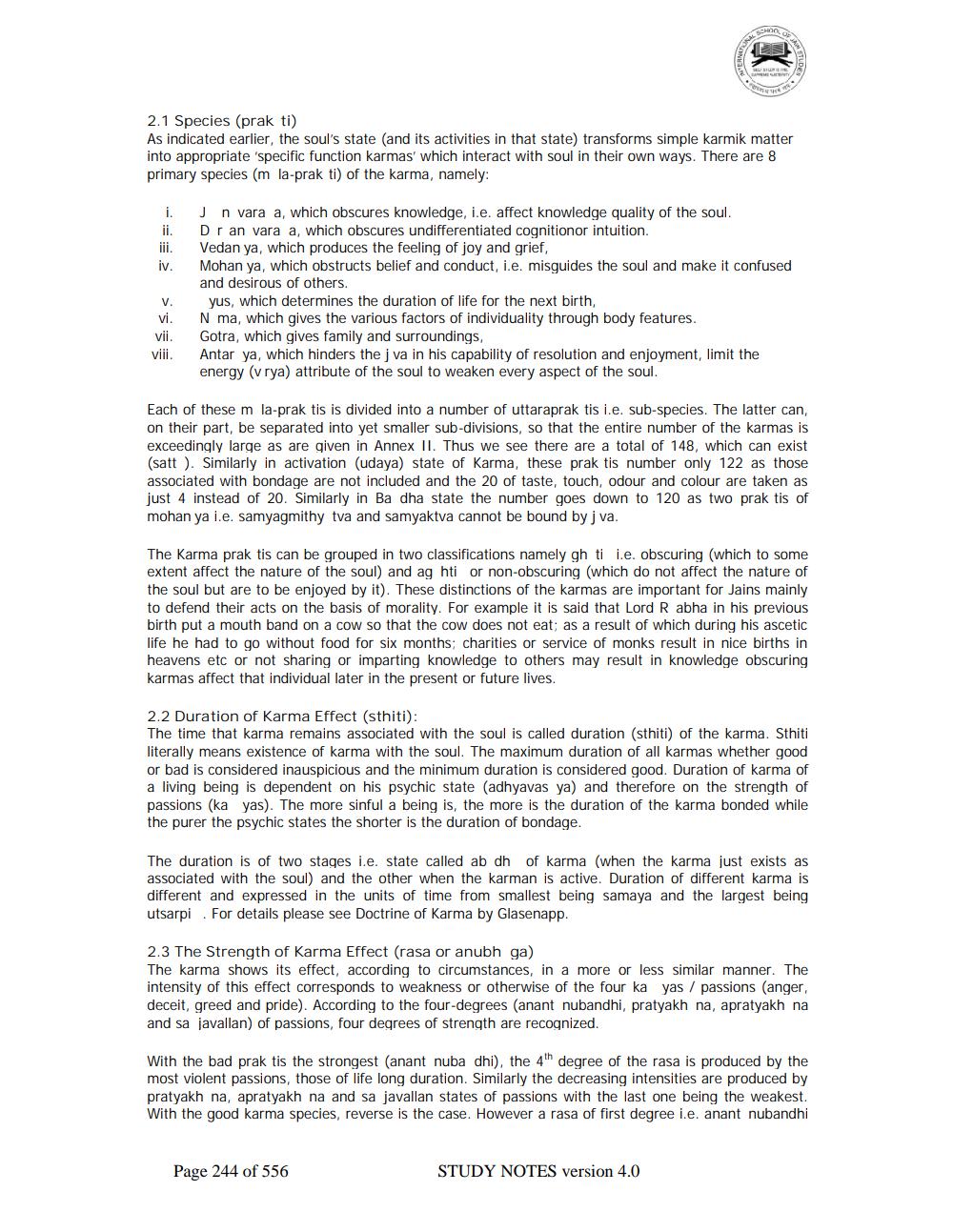________________
2.1 Species (prak ti)
As indicated earlier, the soul's state (and its activities in that state) transforms simple karmik matter into appropriate 'specific function karmas' which interact with soul in their own ways. There are 8 primary species (m la-prak ti) of the karma, namely:
i.
ii.
iii.
iv.
V.
vi.
vii.
viii.
Jn vara a, which obscures knowledge, i.e. affect knowledge quality of the soul.
Dr an vara a, which obscures undifferentiated cognitionor intuition.
Vedan ya, which produces the feeling of joy and grief,
Mohan ya, which obstructs belief and conduct, i.e. misguides the soul and make it confused and desirous of others.
yus, which determines the duration of life for the next birth,
N ma, which gives the various factors of individuality through body features.
Gotra, which gives family and surroundings,
Antar ya, which hinders the j va in his capability of resolution and enjoyment, limit the energy (v rya) attribute of the soul to weaken every aspect of the soul.
Each of these m la-prak tis is divided into a number of uttaraprak tis i.e. sub-species. The latter can, on their part, be separated into yet smaller sub-divisions, so that the entire number of the karmas is exceedingly large as are given in Annex II. Thus we see there are a total of 148, which can exist (satt). Similarly in activation (udaya) state of Karma, these prak tis number only 122 as those associated with bondage are not included and the 20 of taste, touch, odour and colour are taken as just 4 instead of 20. Similarly in Ba dha state the number goes down to 120 as two prak tis of mohan ya i.e. samyagmithy tva and samyaktva cannot be bound by j va.
The Karma prak tis can be grouped in two classifications namely gh ti i.e. obscuring (which to some extent affect the nature of the soul) and ag hti or non-obscuring (which do not affect the nature of the soul but are to be enjoyed by it). These distinctions of the karmas are important for Jains mainly to defend their acts on the basis of morality. For example it is said that Lord R abha in his previous birth put a mouth band on a cow so that the cow does not eat; as a result of which during his ascetic life he had to go without food for six months; charities or service of monks result in nice births in heavens etc or not sharing or imparting knowledge to others may result in knowledge obscuring karmas affect that individual later in the present or future lives.
2.2 Duration of Karma Effect (sthiti):
The time that karma remains associated with the soul is called duration (sthiti) of the karma. Sthiti literally means existence of karma with the soul. The maximum duration of all karmas whether good or bad is considered inauspicious and the minimum duration is considered good. Duration of karma of a living being is dependent on his psychic state (adhyavas ya) and therefore on the strength of passions (ka yas). The more sinful a being is, the more is the duration of the karma bonded while the purer the psychic states the shorter is the duration of bondage.
The duration is of two stages i.e. state called ab dh of karma (when the karma just exists as associated with the soul) and the other when the karman is active. Duration of different karma is different and expressed in the units of time from smallest being samaya and the largest being utsarpi. For details please see Doctrine of Karma by Glasenapp.
2.3 The Strength of Karma Effect (rasa or anubh ga)
The karma shows its effect, according to circumstances, in a more or less similar manner. The intensity of this effect corresponds to weakness or otherwise of the four ka yas / passions (anger, deceit, greed and pride). According to the four-degrees (anant nubandhi, pratyakh na, apratyakh na and sa javallan) of passions, four degrees of strength are recognized.
With the bad prak tis the strongest (anant nuba dhi), the 4th degree of the rasa is produced by the most violent passions, those of life long duration. Similarly the decreasing intensities are produced by pratyakh na, apratyakh na and sa javallan states of passions with the last one being the weakest. With the good karma species, reverse is the case. However a rasa of first degree i.e. anant nubandhi
Page 244 of 556
STUDY NOTES version 4.0




